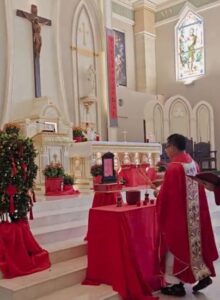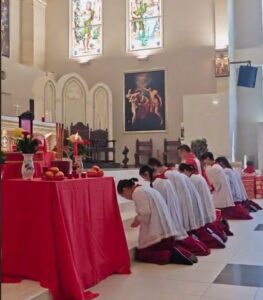 |
 |
I have been asked several times about my view on a Tik Tok video which shows a church conducting its Chinese New Year or Spring Festival worship which seems to follow the form of the Chinese ritual of ancestor worship or veneration.
My response to this video is based on how practitioners of this kind of rituals normally justify their adoption of the form of “ancestor worship or veneration. It is also based on my personal experience of similar worship during my younger pagan days.
One may argue that offering incense is in the Bible. OK, I can give some benefit of doubt on this matter. That is, putting three incense joss sticks is debatable and defensible – assuming worship & acknowledgement of the Triune God in heaven with NO images. Context matters.1[Additional footnote added on 14/04/2025 as clarification – Context matters. I wont approve putting a joss stick in front of an ancestral tablet, or the earth god tablet etc.- because according to pagan beliefs, the spirits of the ancestors or the spirit of the earth god resides within the tablets. This is idolatry even though there are no images. Conceivably, someone may just put joss sticks in an urn to offer incense to the “heavenly god/God” without a tablet or images – well, we can discuss to find out what exactly the one who puts the joss stick has in mind & decide accordingly. However, in reality (except for a Chinese cult, which existed briefly in the 1970s), 99+ % of the people put the joss sticks in front of some kinds of tablets which are understood to be residences of spirits. This would be idolatry. The case of the tablet in the video is ambiguous because I don’t know what is in the tablet – but if what is written in the tablet encourages or is in line with the customary idea of tablets being places of residence of any spirit(s), then it would be idolatry. The presumption is that the presence of the tablet is likely to become a stumbling block and therefore is best not used at all].
Does the tablet in front of the table contain only Bible verses praising the Triune God without images? If there is no image, then the ritual could be discussed. But I doubt it as bible verses tablets have not become common place in church worship rituals. What is written in the tablet would make a crucial difference to the nature of the ritual as it could be some Chinese characters describing the “sky god” Tian (天), the “earth god” Tudigong (土地公), and the “kitchen god” is known as Zao Shen (灶神). The presence of these references would certainly be problematic. Looks like this video pertains more towards some form of ancestor veneration/worship.
Bowing is part of veneration of our ancestors. This could be the case here. Roman Catholics & some liberal theologians argue that ancestor veneration is not the same with ancestor worship, but I am not so sure. If bowing with joss sticks to ancestor spirits is the same action as bowing to the gods with joss sticks, how can they not have the same meaning & significance?
Presumably the worship ritual here adopts similar/familiar Chinese cultural forms so as to connect to wider (Chinese) culture. It is to encourage the recipient culture not to reject Christianity out of hand because of unfamiliarity- but the similarity of forms should be kept to a minimum. But the ritual in this video is typically the same as Chinese worship ceremonies. There must be abundance of caution even when we are trying to be generous in giving the benefit of doubt.
Kneeling & bowing to the image of the crucified Christ in front of the church also borders towards some forms of idolatry, just like bowing to images of the pagan gods practiced in my pagan life. Hard for me to accept this kind of worship. The priest may give some abstract rationalization or excuses, but for most of the worshippers in the pew, kneeling & bowing before concrete images with offerings of incense, food & candles would decisively shape the perception and the attitude/feeling of their worshipping hearts. There is also the superstitious belief in the intrinsic efficacy of rituals – that is in securing the approval and blessings of the ancestor spirits. It would be difficult to differentiate the worship attitude of both the average Christian worshippers and pagans in this kind of ancestor worship when they both are bowing before the images/idols.
The offering three cups of wine & food goes beyond the caution as they remind me of my old pagan mindset. Somehow the gods/ancestor spirits accepted & ‘drank & ate’ the offerings. I find it hard accept this idea. Right in the New Testament times, Christians stuck to a sanctified form for worship that is full of its distinctive meaning – the Holy Communion without compromise.
The NT Christians were surrounded by pagan religions with all kinds of meals shared with their gods – from OT pagan meals – wine and meal offerings offered to the Queen of heaven (Ashtoreth and Astarte c.f. Jer. 7:18, 44: 17-25, offerings offered to NT mystery religions gods like in Mithraism), but the NT Christians deliberately & uncompromisingly stuck to a totally different ritual, the holy communion of bread & wine centred on the death of Jesus Christ. They made sure that the central message of Christ sacrificial redemptive death was not confused with pagan forms & ideas.
For us today, the key question is what additional elements could be introduced & emphasized for communion during the Chinese Spring Festival (New Year). Having Holy Communion to celebrate the saving death of Christ would become more meaningful during Spring Festival by emphasizing that the death & resurrection of Christ confirms and renews our Christian hope. As the Spring Festival celebrates the renewal of life and creation after a dead winter – Christ died both to save sinful humanity & bring a new creation (new heavens & new earth):
– Rom. 8: 18-21 For I consider that the sufferings of this present time are not worth comparing with the glory that is to be revealed to us. 19 For the creation waits with eager longing for the revealing of the sons of God. 20 For the creation was subjected to futility, not willingly, but because of him who subjected it, in hope 21 that the creation itself will be set free from its bondage to corruption and obtain the freedom of the glory of the children of God.
– Rev. 21: 1, 4. Then I saw a new heaven and a new earth, for the first heaven and the first earth had passed away, and the sea was no more… He will wipe away every tear from their eyes, and death shall be no more, neither shall there be mourning, nor crying, nor pain anymore, for the former things have passed away.”
– Isa. 66: 22 – “For as the new heavens and the new earth that I make shall remain before me, says the Lord, so shall your offspring and your name remain. 😃 [If there were ancestor spirits – they should rejoice at this promise from the God of the Bible – just arguing to gain points].
In short, we should avoid adopting pagan elements & ideas for Christian worship presented in the video during the Spring Festival or Chinese NY. But we should be creative and introduce biblically informed elements so that Christian worship both celebrates & renews our hope in the promise of God to bless believers each with a new glorified body and to restore fallen creation when Christ comes again.
Related Post
On the Pope Dotting the Eye of the Dragon
Link to the Tik Tok video discussed in the post – https://www.tiktok.com/@loy.aaron/video/7465264799346281746?_r=1&_t=ZS-8tUEBH3HzFs